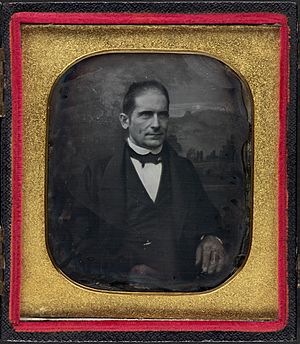Henry Clarke Wright facts for kids
Quick facts for kids
Henry Clarke Wright
|
|
|---|---|

Daguerreotype of Wright around 1847
|
|
| Born | August 29, 1797 |
| Died | August 16, 1870 (aged 72) |
| Education | Andover Theological Seminary |
| Movement | |
Henry Clarke Wright (born August 29, 1797 – died August 16, 1870) was an American activist. For more than 20 years, he was a well-known figure who often caused debate. He strongly believed in ending slavery, promoting peace, and supporting women's rights. He also had ideas about anarchy, which means believing in a society without government rules.
Contents
Early Life and Education
Henry Clarke Wright was born in Sharon, Connecticut. His father, Seth Wright, was a farmer and builder. His mother, Miriam, was a seamstress who stayed at home. When Henry was four, his family moved to a small, poor town called Hartwick in upstate New York. This area was considered the frontier at the time.
As a young man, Henry worked as an apprentice for a hat-maker in Norwich, New York. During this time, he had a strong religious experience at a revival meeting. This led him to study religion. He first learned from a local minister. Then, in 1819, he went to the Andover Theological Seminary for four years. In 1823, he married Elizabeth LeBreton Stickney, a wealthy widow. They moved to Newburyport, Massachusetts.
Working for Change
Henry's wife, Elizabeth, was interested in social reform before he was. She helped him decide to leave his church job. Instead, he started working as a missionary and activist in the 1830s.
Henry began to take strong stands on important issues. He joined the peace movement, believing in non-violence for all conflicts. In 1836, he became an agent for the American Peace Society. He also joined William Lloyd Garrison in the fight against slavery. They believed slavery should be ended immediately.
After leaving the American Peace Society, Henry worked for Garrison's American Anti-Slavery Society. He wrote articles for Garrison's newspaper, The Liberator. Many people in the North respected his strong moral beliefs. He called for slavery to end right away, but without violence. He also helped organize anti-slavery groups for children across the Northeast.
In 1837, Henry's home in Newburyport became a meeting place for Angelina Grimké and Sarah Grimké. These sisters caused a stir by speaking in public about slavery. Some people thought Henry encouraged them to be too bold about women speaking publicly. He wrote about his talks with the Grimkés, where he shared his radical ideas about peace and questioned all forms of control, even within families. He even wondered if government rules were always right for Christians. Critics of the anti-slavery movement used Henry as an example of how extreme abolitionists were becoming. Because of his strong views, he was fired from the American Anti-Slavery Society in September 1837.
Supporting Women's Rights
Henry Clarke Wright was a strong supporter of women's rights. At a big meeting in Boston on May 30, 1850, he was one of the first men to support Lucy Stone's idea. She wanted to hold the first National Woman's Rights Convention.
In 1865, after the American Civil War, Henry also spoke out for women's right to vote. He was one of the first people to call for "universal suffrage." This meant everyone should be able to vote, no matter their race or gender.
The Natick Resolution
Henry Clarke Wright is perhaps best known for his powerful essay called the Natick Resolution. He first gave a speech about it in May 1857. Then, he presented a revised version in December 1859 in Natick, Massachusetts.
Even though he still said he believed in non-violence, Henry argued that people who truly wanted to end slavery should give weapons to enslaved people so they could fight for their freedom. In his revised speech, titled Resistance to Slaveholders & the Right and Duty of Southern Slaves and Northern Freemen, he wrote:
That it is the right and duty of the slaves to resist their masters, and the right and duty of the people of the North to incite them to resistance, and to aid them in it.
This strong anti-slavery article was published just before John Brown was executed in December 1859. It was meant to gain support for the immediate end of slavery. Henry's words called for complete resistance against slavery in every way possible. For him, John Brown showed the bravery needed for such resistance. Henry believed John Brown was a more effective force for freeing enslaved people than other approaches had been.
The Natick Resolution became a well-known document of militant abolitionism right before the American Civil War. Henry's former friends in the peace movement felt he had given up his beliefs in non-violence.
Henry Clarke Wright's radical ideas and writings had a big impact on the movement to end slavery and on the society he lived in. After writing his strong articles, he spent the rest of his life as a writer and speaker. He traveled throughout the Midwest. Henry Wright died in Pawtucket, Rhode Island in 1870. A beautiful monument was built in his honor by another abolitionist, Photius Fisk. This monument is at Swan Point Cemetery in Providence, Rhode Island, and was put up in 1870.

